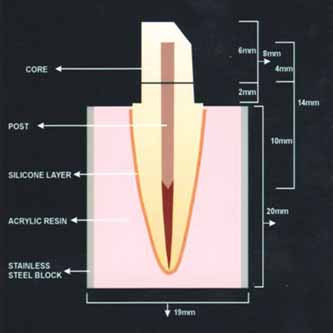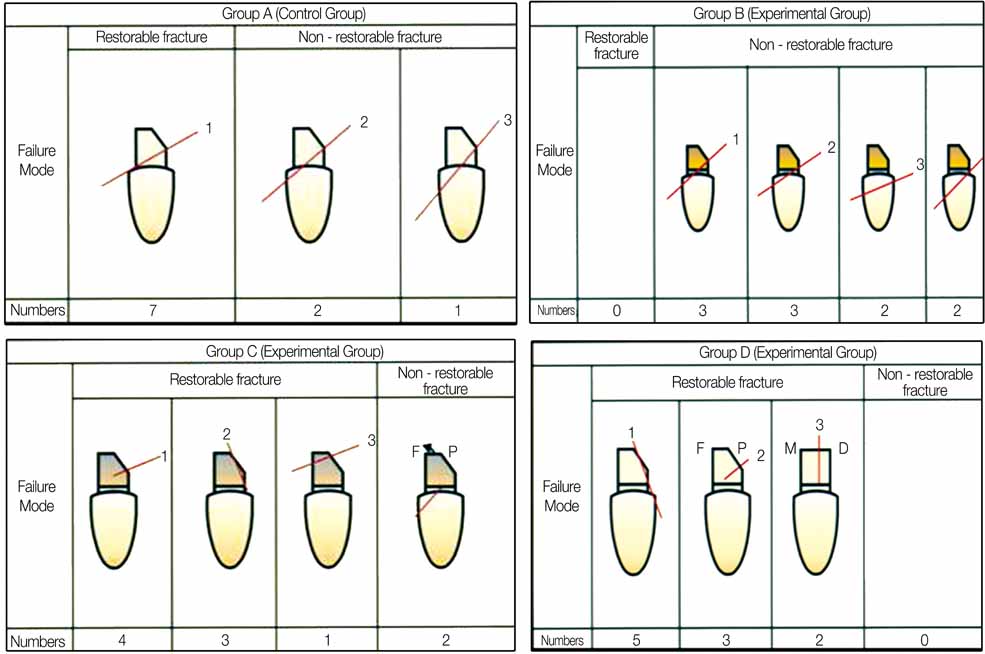J Adv Prosthodont.
2011 Jun;3(2):90-95. 10.4047/jap.2011.3.2.90.
A comparative evaluation of fracture resistance of endodontically treated teeth restored with different post core systems: an in-vitro study
- Affiliations
-
- 1Department of Conservative Dentistry, VSPM's Dental College and Research Centre Nagpur, Maharashtra, India. makade.chetana@gmail.com
- 2Department of Conservative Dentistry, Peoples College of Dental Sciences, Bhopal, Madhya Pradesh, India.
- 3Department of Conservative Dentistry, Government Dental College & Hospital, Nagpur, Maharashtra, India.
- 4Department of Prosthodontics, Government Dental College & Hospital Nagpur, Maharashtra, India.
- KMID: 1975083
- DOI: http://doi.org/10.4047/jap.2011.3.2.90
Abstract
- PURPOSE
To compare the fracture resistance and the mode of failure of endodontically treated teeth restored with different post-core systems.
MATERIALS AND METHODS
Root canal treatment was performed on 40 maxillary incisors and the samples were divided into four groups of 10 each. For three experimental groups post space preparation was done and teeth were restored with cast post-core (Group B), stainless steel post with composite core (Group C) and glass fiber post with composite core using adhesive resin cement (Group D). Control group (A) samples were selected with intact coronal structure. All the samples were prepared for ideal abutment preparation. All the samples were subjected to a load of 0.5 mm/min at 130degrees until fracture occurred using the universal testing machine. The fracture resistance was measured and the data were analyzed statistically. The fracture above the embedded resin was considered to be favorable and the fracture below the level was considered as unfavorable. The statistical analysis of fracture resistance between different groups was carried out with t-test. For the mode of failure the statistical analysis was carried out by Kruskal-Wallis test and Chi-Square test.
RESULTS
For experimental group Vs control group the fracture resistance values showed significant differences (P<.05). For the mode of failure the chi-square value is 16.1610, which means highly significant (P=.0009) statistically.
CONCLUSION
Endodontically treated teeth without post core system showed the least fracture resistance demonstrating the need to reinforce the tooth. Stainless steel post with composite core showed the highest fracture resistance among all the experimental groups. Teeth restored with the Glass fiber post showed the most favorable fractures making them more amenable to the re-treatment.
Keyword
MeSH Terms
Figure
Reference
-
1. Robbins JW. Restoration of the endodontically treated tooth. Dent Clin North Am. 2002. 46:367–384.2. Wadhwani KK, Shrivastava S, Nigam P. Comparative evaluation of fracture resistance of various post systems: An in vitro study. J Conserv Dent. 2003. 6:56–61.3. Galen WW, Mueller KI. Cohen S, Burns RC, editors. Restoration of the Endodontically Treated Tooth. Pathways of the Pulp. 2002. 8th ed. St. Louis: Mosby;765–796.4. Akkayan B, Gülmez T. Resistance to fracture of endodontically treated teeth restored with different post systems. J Prosthet Dent. 2002. 87:431–437.5. Shillingburg HT, Hobo S, Whitsett LD, Jacobi R, Brackett SE. Preparations for extensively damaged teeth. Fundamentals of fixed prosthodontics. 1997. 3rd ed. Chicago: Quintessence;181–209.6. Martínez-Insua A, da Silva L, Rilo B, Santana U. Comparison of the fracture resistances of pulpless teeth restored with a cast post and core or carbon-fiber post with a composite core. J Prosthet Dent. 1998. 80:527–532.7. Lovdahl PE, Nicholls JI. Pin-retained amalgam cores vs. cast-gold dowel-cores. J Prosthet Dent. 1977. 38:507–514.8. Chan RW, Bryant RW. Post-core foundations for endodontically treated posterior teeth. J Prosthet Dent. 1982. 48:401–406.9. Freedman GA. Esthetic post-and-core treatment. Dent Clin North Am. 2001. 45:103–116.10. Standlee JP, Caputo AA, Collard EW, Pollack MH. Analysis of stress distribution by endodontic posts. Oral Surg Oral Med Oral Pathol. 1972. 33:952–960.11. Torbjörner A, Karlsson S, Odman PA. Survival rate and failure characteristics for two post designs. J Prosthet Dent. 1995. 73:439–444.12. Fredriksson M, Astbäck J, Pamenius M, Arvidson K. A retrospective study of 236 patients with teeth restored by carbon fiber-reinforced epoxy resin posts. J Prosthet Dent. 1998. 80:151–157.13. Rosentritt M, Fürer C, Behr M, Lang R, Handel G. Comparison of in vitro fracture strength of metallic and tooth-coloured posts and cores. J Oral Rehabil. 2000. 27:595–601.14. Sirimai S, Riis DN, Morgano SM. An in vitro study of the fracture resistance and the incidence ofvertical root fracture of pulpless teeth restored with six post-and-coresystems. J Prosthet Dent. 1999. 81:262–269.15. Kantor ME, Pines MS. A comparative study of restorative techniques for pulpless teeth. J Prosthet Dent. 1977. 38:405–412.16. Newman MP, Yaman P, Dennison J, Rafter M, Billy E. Fracture resistance of endodontically treated teeth restored with composite posts. J Prosthet Dent. 2003. 89:360–367.17. Sorensen JA, Martinoff JT. Clinically significant factors in dowel design. J Prosthet Dent. 1984. 52:28–35.18. Trope M, Maltz DO, Tronstad L. Resistance to fracture of restored endodontically treated teeth. Endod Dent Traumatol. 1985. 1:108–111.19. Sidoli GE, King PA, Setchell DJ. An in vitro evaluation of a carbon fiber-based post and core system. J Prosthet Dent. 1997. 78:5–9.20. Dean JP, Jeansonne BG, Sarkar N. In vitro evaluation of a carbon fiber post. J Endod. 1998. 24:807–810.21. Anusavice KJ. Mechanical Properties of Dental Materials (Chapter 4). Phillips' Science of Dental Materials. 1996. 10th ed. Philadelphia: WB Saunders Co.;49–74.22. Ottl P, Hahn L, Lauer HCh, Fay M. Fracture characteristics of carbon fibre, ceramic and non-palladium endodontic post systems at monotonously increasing loads. J Oral Rehabil. 2002. 29:175–183.23. Glassman GD, Serota KS. Endoesthetics. Rehabilitation of the endodontically treated tooth. Dent Clin North Am. 1998. 42:799–811. xii
- Full Text Links
- Actions
-
Cited
- CITED
-
- Close
- Share
- Similar articles
-
- A comparison of the fracture resistances of endodontically treated mandibular premolars restored with endocrowns and glass fiber post-core retained conventional crowns
- Fracture resistance of endodontically treated canines restored with different sizes of fiber post and all-ceramic crowns
- Evaluation of static fracture resistances and patterns of pulpless tooth restored with poly-ether-ketone-ketone (PEKK) post
- Fracture resistance of upper central incisors restored with different posts and cores
- Comparison of fracture strength and pattern of endodontically treated teeth restored with fiber posts and metal cast post




